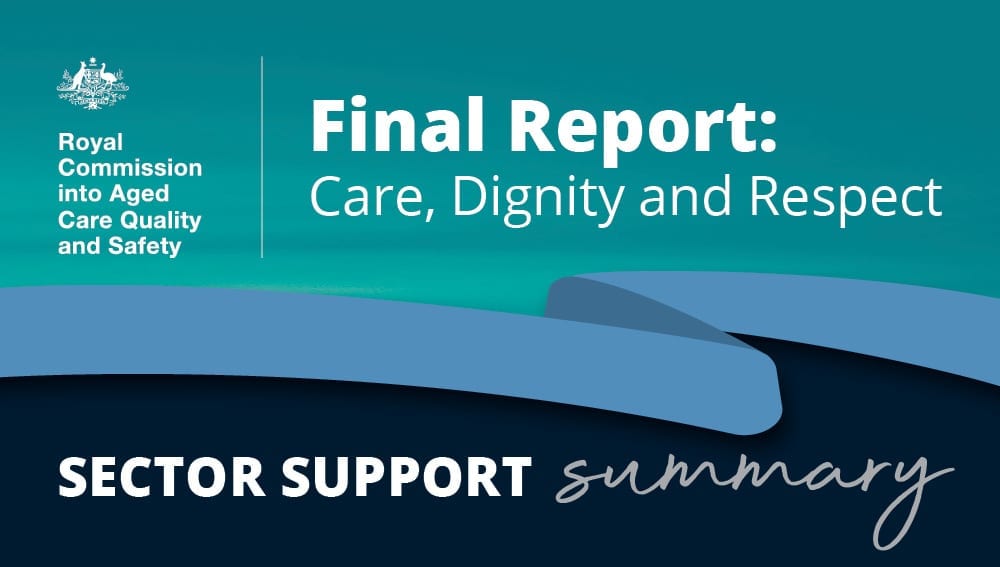Sector Support Summary of Royal Commission into Aged Care Quality and Safety

Written by Ilsa Bird, Sector Support Coordinator
“The extent of substandard care in Australia’s aged care system reflects both poor quality on the part of aged care providers and fundamental systematic flaws with the way the Australian aged care system is designed and governed. People receiving aged care deserve better… we both strongly conclude that fundamental change is needed.”
– Royal Commissioners Tony Pagone QC & Lynelle Briggs AO
After nearly two and a half years of hearings, The Royal Commission into Aged Care Quality and Safety handed their recommendations to the Federal Government on 26 February 2021. Over the course of the Royal Commission, clear common themes have been identified including dignity and respect, control and choice, the importance of relationships and connections to communities, the desire for a good quality of life and ageing at home. In this article, we will outline the contents of the final report, the Government’s response and how providers can proactively prepare for change in the aged care sector in the coming years.
We’ve summarised over 2000 pages into 7 pages. To read or print this summary please CLICK HERE
How has the Government responded?
“I warned the country we should brace for impact and be prepared for what would follow and it has been a harrowing process.”
– Prime Minister Scott Morrison
The Government’s initial response to the Final Report was announced on 1 March 2021. The Health Minister Greg Hunt mapped out a $452 million immediate response to the report built on five “pillars”:
- Home care
- Quality and safety
- Services and sustainability
- Workforce; and
- Governance
These pillars include immediate measures such as:
- $18.4 million for greater oversight of home care packages, program of audits of 500 home care providers to reduce unjustified administrative charges, and better fraud controls.
- $32 million for strengthening provider quality including expanded powers for the Aged Care Quality and Safety Commission including a “Senior Restraint Practitioner” to boost regulation of physical and chemical restraints.
- $279.9 million for residential care temporary financial support including continuation of the 30% rise in homeless and viability supplements until the end of June, and targeted support for residential aged care providers in financial stress.
- $91.8 million to attract 18,000 job seekers to enter the home and residential aged care workforce.
- $30.1 million for Governance including training for aged home board members, stronger quality standards, and an overhaul of the Aged Care Act which has been in place since 1997.
A full allocation of funding will be announced in the Federal budget and as per recommendation 145 in the Final Report, the full Government response is expected to be announced by 31 May 2021.
How can providers prepare for change?
In the coming years, the aged care sector will go through a period of significant systematic change and reform. Although it is difficult to determine exactly how and when these changes will occur, we know a new aged care roadmap will be released to outline the rollout of future changes. But, how can you proactively prepare for change now? The best way to do this is through scenario planning. Consider which of these recommendations will most significantly impact your staff, clients and organisation. Then determine the challenges and create strategies to best respond.
Below are some few points for consideration:
 | WORKFORCE – consider how you will adapt your recruitment processes to meet the demand for care at home. What extra roles will need to be recruited for over the next 5 years? Consider how you might draw on skills from other sector |
 | EDUCATION & TRAINING – consider how you will support your staff to meet the mandatory requirements for qualifications and professional development. What internal infrastructure needs to be implemented? How will you work with external Registered Training Organisations (RTOs)? |
 | GOVERNANCE – consider the skills mix of your Board, Executives and Management. Do you have the expertise required to navigate organisational change to adhere to the recommendations? |
 | FINANCING – consider ways in which you would finance additional costs that are not covered by funding, particularly if prices for service provision are set by an independent body. This may also include the capital required to transform your organisation to respond to relevant recommendations. |
 | OPERATIONS – consider how these recommendations may impact your current organisational policies and procedures. How might these be updated, by whom and when? Consider your change management strategies, how will you manage and communicate change? |
 | REPORTING – consider how increased reporting and transparency would impact your organisation? Who will be responsible for this? This may require improved IT systems, database upgrades and IT roadmaps to produce comprehensive reporting and clearer data patterns. Consider how you can self-publish and share data in order to practice transparency for your consumers, clients. |
 | QUALITY & SAFETY – consider how quality is valued, resourced, measured and reported in your organisation and how you can improve. Is quality based on compliance or excellence? What might the new quality indicators for home care look like? |
 | INNOVATION – instead of waiting for Government to tell you what to do, take this time to research, design and co-design innovative solutions. |
Although the recommendations may be somewhat overwhelming, it is important to begin preparing for change. The proposed timeline for the implementation of the recommendations is five years however; some changes could be implemented as early as mid-late 2021.
To stay up to date with important sector changes and announcements related to the Royal Commission, sign up to our monthly eBulletin here.
To access the Final Report and supplementary documents, please see the links below:
HERE ARE 10 KEY TAKE AWAYS FROM THE FINAL REPORT: CLICK HERE